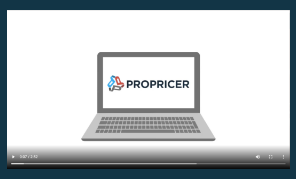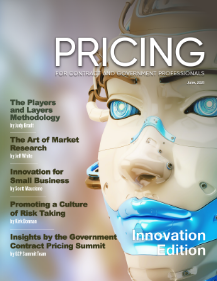Adopting disruptive pricing models and technology can often feel...like a disruption. How can we keep traditional pricing models, such as Lowest Bid, Best Value Procurement, Performance-based, and Shared Services, in our back pockets, while making room for innovative applications?
New processes are here to stay, propelling agencies to explore, learn, build, and scale repeatable pricing models. But they have their risks.
It’s good to take a complementary approach. Accurate modeling scenarios, cloud-based management tools, creative financing, and discovery days should act as complementary strategies, rather than replacements for traditional methods.
The “bright shiny” methods don’t need to be used in every pricing scenario, but you can gradually work them into your repertoire, as their vulnerabilities decrease over usage and time.
Leverage Big Data to deliver accurate modeling scenarios
“Moneyball for Procurement.” Don’t rely on your intuition. Leverage data, analytics, and performance metrics to make accurate and reliable procurement decisions.
Optimization-based sourcing tools. Audit your supply chain manufacturer and shipment costs; contract the most cost-effective suppliers.
Analytics, discovery, and search tools. Put Contract Intelligence at your fingertips. Merge accurate reporting with advanced algorithms to search, study, and compare in a fraction of the time.
Predictive analytics. “Past is the greatest indicator of future performance.” Analyze successful spending, supply chain, and market data to develop accurate pricing models.(3)
Optimize expenses through new management tools & finance strategies
Performance or savings management tools. Don’t duplicate your efforts scouring databases for reports multiple times. Organize expenses and cost savings with cloud-based management programs to automatically compare pricing and performance.
Dynamic discounting. Apply discounts based on the dates of payment to suppliers. In other words, ask for a reduction if you pay super early.
Supply chain financing. Finance your receivables to reduce risk of supply chain disruption and optimize working capital. (3)
Welcome the future, a little ahead of schedule
Blockchain. Blockchain software is changing the workforce landscape for government procurement. Develop a seamless recruitment, vetting, and payment process for freelancers in a secure, trackable platform.
Machine learning. Detect patterns and improve the accuracy of predictive models.
Artificial intelligence. It’s been the tech buzz word for a few years, but how does it apply to real-world applications? Utilizing these rule-based business behaviors, most manual contract administration activities can be 100% phased out within a few years.
Natural language processing. Enable speech recognition to prompt AI—think helpful chatbots and commands—to issue orders or complete organizational tasks. (4)
Curate agency-sponsored innovation labs and industry days
Procurement Innovation Lab (PIL). Innovation is often light-years ahead of government information technology. Bridging the tech time-lapse, PIL is a marketplace designed to showcase supplier innovation and IT best practices. Using discovery as the main objective, the lab has leveled the competitive playing field for small and large tech businesses seeking awards.
Reverse industry days. Similar to PIL, reverse industry days are another opportunity for procurement specialists and contractors to hold an open forum for discussion, questions, and suggestions. Both sides can discuss RFP pain points and how contractors determine bid-worthy contracts. The end goal? Apply relevant feedback, review techniques, and ultimately improve the procurement process for both sides. (1)
Bring in the new. And the old.
Innovative methods and legacy processes can coexist. Procurement specialists don’t need to discontinue one method to make room for newer strategies. And often, traditional pricing techniques are still more cost-effective and relevant.
However, if a proven “futuristic” concept is agile enough to use and build successful, repeatable models, then, as a contract officer, you have to be willing to adapt and apply the technology. (5)
Software programs like ProPricer Government Edition can bridge the gap between traditional and newer pricing models by providing detailed and accurate reports…with, of course, minimal disruption. Request a demo here.
- DHS Procurement Innovation Lab Chief: 'We Succeed or Fail Together'
- Innovation in Procurement: How CPOs Can Deliver Value
- Advanced Sourcing and Procurement Technologies – A Series Introduction
- Is Blockchain a “Future of Work” Gamechanger?
- Transforming Procurement in Five Steps: Step Two – Processes





